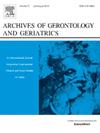日本中老年社区居民的人体测量、身体组成和身体功能的年龄相关变化:一项纵向研究
IF 3.8
3区 医学
Q2 GERIATRICS & GERONTOLOGY
引用次数: 0
摘要
目的量化不同出生人群身高、体重、握力的年际变化,建立人口标准化老龄化曲线。方法:这项纵向研究分析了来自美国国家长寿科学研究所——老龄化纵向研究的数据,追踪了1901名年龄在40 - 79岁之间的社区居民,为期12年。身高、体重、身体质量指数(BMI)、体脂率、骨骼肌质量和握力的年变化采用线性混合效应模型按性别进行评估。根据性别,使用在1997年至2022年(n = 1990)期间至少参加过一次浪潮的参与者,使用广义加性混合模型开发了出生队列特定参考值。结果男性的身高、体重、BMI、骨骼肌质量和握力在随访年数与年龄之间存在显著负相关(p值均为<;0.001),以及女性的身高、体重、BMI、体脂百分比和骨骼肌质量(所有p值<;0.01)。握力在其他指标发生重大变化之前就开始下降。对于身高和握力,年龄相关变化的出生队列特定参考值显示,随着年龄的增长,男女都逐渐下降,最近出生的队列始终较高,但握力较早的队列弱。男性在60 - 70岁之前体重会轻微增加,随后体重会下降。女性的体重一直保持稳定,直到60岁才开始下降。结论这些参考值为检测相对健康参与者的身体成分和功能的年龄相关变化提供了循证工具,并指导临床和社区环境中的预防干预。本文章由计算机程序翻译,如有差异,请以英文原文为准。
Age-related changes in anthropometric measurements, body composition, and physical function among middle-aged and older Japanese community-dwellers: A longitudinal study
Objective
To quantify annual changes and develop population-normalized aging curves for height, body weight, and grip strength according to specific birth cohorts.
Methods
This longitudinal study analyzed data from the National Institute for Longevity Sciences – Longitudinal Study of Aging, following 1901 community-dwelling adults aged 40−79 years for up to 12 years. Annual changes in height, body weight, body mass index (BMI), body fat percentage, skeletal muscle mass, and grip strength were assessed by sex using linear mixed-effects models. Birth cohort-specific reference values according to sex were developed using participants who participated in at least one wave between 1997 and 2022 (n = 1990) with generalized additive mixed models.
Results
Significant negative follow-up years × age interactions were observed for height, body weight, BMI, skeletal muscle mass, and grip strength in men (all p-values < 0.001) and for height, body weight, BMI, body fat percentage, and skeletal muscle mass in women (all p-values < 0.01). Grip strength began declining preceding any significant change in other indicators. For height and grip strength, birth cohort-specific reference values for age-related changes showed a gradual decline with age in both sexes, with more recent birth cohorts being consistently taller but having weaker grip strength than earlier cohorts. Men experienced slight weight increases until ages 60−70 years, followed by a decline. Women maintained a stable weight until age 60 years before declining.
Conclusions
These reference values provide evidence-based tools for detecting age-related changes in body composition and function among relatively healthy participants and guiding preventive interventions in clinical and community settings.
求助全文
通过发布文献求助,成功后即可免费获取论文全文。
去求助
来源期刊
CiteScore
7.30
自引率
5.00%
发文量
198
审稿时长
16 days
期刊介绍:
Archives of Gerontology and Geriatrics provides a medium for the publication of papers from the fields of experimental gerontology and clinical and social geriatrics. The principal aim of the journal is to facilitate the exchange of information between specialists in these three fields of gerontological research. Experimental papers dealing with the basic mechanisms of aging at molecular, cellular, tissue or organ levels will be published.
Clinical papers will be accepted if they provide sufficiently new information or are of fundamental importance for the knowledge of human aging. Purely descriptive clinical papers will be accepted only if the results permit further interpretation. Papers dealing with anti-aging pharmacological preparations in humans are welcome. Papers on the social aspects of geriatrics will be accepted if they are of general interest regarding the epidemiology of aging and the efficiency and working methods of the social organizations for the health care of the elderly.

 求助内容:
求助内容: 应助结果提醒方式:
应助结果提醒方式:


